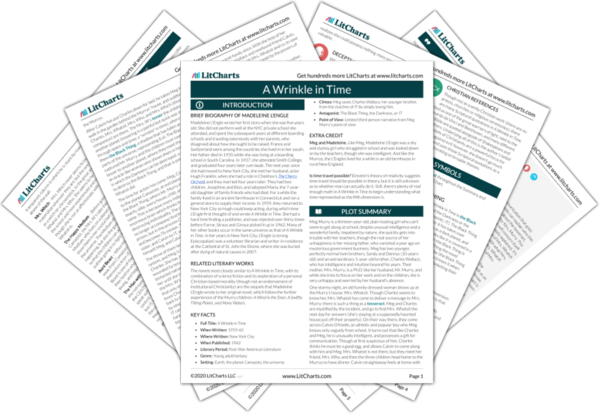Summary
Analysis
Though Mr. Murry is at first against it, he consents to allowing these beasts to take Meg to heal her, since they reveal that they are also fighters against the Black Thing. They reveal that it is, in fact, tessering through the Black Thing that has caused Meg's injuries. Despite herself, Meg feels calm and safe and healed simply by being in the arms of the beast, and she falls asleep.
Mr. Murry's reluctance to allow the beasts to take Meg seems to emerge from his dislike of their physical appearance. But communication breaks through that initial sight-based distrust, revealing similarities, common goals, and basic goodness.
Themes
When she wakes up, Meg finds herself in a room feeling far better than before, with the beast sitting by her bed. It's very dark in the room, so she asks the beast why there is no light. It turns out that these beasts have no sense of vision, nor do they need it. Meg fumblingly tries to describe what light is and why humans need to see, but the beast is utterly perplexed by her explanations.
The exchange between Meg and the beast plays with ideas of knowing and communication—how does one "understand" or "explain" seeing to someone who doesn't need to see? In Meg's failure to communicate light and seeing comes the realization that these things can't be explained, that they are beyond the simple answers Meg always seeks. Yet there is also a different communication going on as well, which is simply the effort to know each other, the desire to know each other, that permeates Meg's conversation with the beast. There is growing friendship that comes not from the successful bridging of difference but from the mere effort to bridge it.
Themes
Their discussion turns to Charles Wallace, and as soon as Meg begins blaming her father for abandoning him, the beast becomes stern, telling her: "Nobody said anything about abandoning anybody. That is not our way. But we know that just because we want something does not mean that we will get what we want, and we still do not know what to do." The beast then talks of how Meg must first rest and get better before anything is done, and suggests that Meg give the beast—a her—a name that feels appropriate. After some thought, Meg gives the beast the name Aunt Beast, because she has treated her with almost as much love as Meg's own mother. Aunt Beast then sings Meg to sleep, and listening to the indescribable beauty of the music, Meg understands that she herself, not the beasts, is limited by her dependency on sight.
The beast's stern response to Meg criticizes Meg's desire for easy answers. Meg wants her father to have saved Charles easily, to have just known how to do it, and that he couldn't makes her so upset that she blames him in unfair ways. But the beast's response highlights that there was no easy answer, and that the desire for something doesn't mean you just get it. The beast is helping Meg to grow up. At the same time, the beast treats Meg with love, and that love creates a connection between them. Meg no longer feels revulsion at the beast, and the name she chooses places the beast as being part of her family. Love creates those bonds. Also, once again, the novel depicts Christian ideals extending beyond Earth when Aunt Beast quotes Scripture. The universe's fighters for the good seem to have Scripture as a common reference point.
Themes
The next morning, Meg awakens, feeling refreshed. She asks Aunt Beast about what planet they're on; it turns out they're on the planet Ixchel, which is in the same solar system as Camazotz, but which fights against the Black Thing. Aunt Beast then takes Meg to an open hall, where Calvin and Mr. Murry and many others of the beasts are eating and waiting for her. As soon as she sees her father, all of Meg's bitterness and disappointment towards him returns in a rush. She tells them all sulkily that their only hope is to call the Mrs. W's. When the beasts ask her to explain who the Mrs. W's are, Meg is so limited by her visual conception of the Mrs. W's that her descriptions only make the beasts confused. Calvin, the talented communicator, explains them somewhat better as angels or messengers of God, but the beasts still don't understand…when suddenly Mrs. Whatsit, Mrs. Who, and Mrs. Which appear!
In Meg's failure to explain he Mrs. W's the novel once again depicts the failings of knowing something by what it looks like, since to do so is not representative of the things' essence. In likening the Mrs. W's to angels, Calvin makes it clear that God is the ultimate representation of good in this universe, or that at minimum the idea of God is an allusion that all beings in the universe can understand.
Themes
Get the entire A Wrinkle in Time LitChart as a printable PDF.













